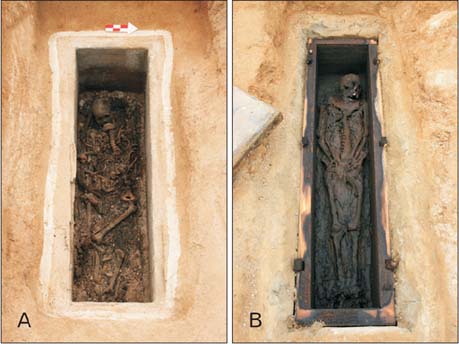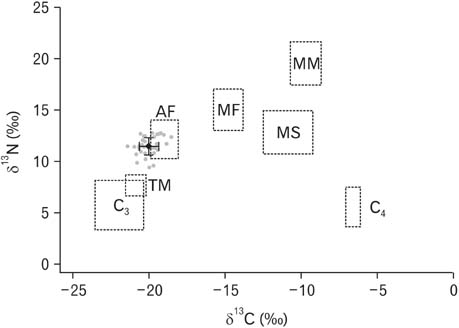Anat Cell Biol.
2014 Dec;47(4):244-252. 10.5115/acb.2014.47.4.244.
Stable isotope analysis of Joseon people skeletons from the cemeteries of Old Seoul City, the capital of Joseon Dynasty
- Affiliations
-
- 1Department of Anatomy, Seoul National University College of Medicine, Seoul, Korea. cuteminjae@gmail.com
- 2Department of Anatomy, Ehwa Womans University School of Medicine, Seoul, Korea.
- 3Hangang Institute of Cultural Heritage, Seoul, Korea.
- 4Sangmyung University, Seoul, Korea.
- KMID: 1882603
- DOI: http://doi.org/10.5115/acb.2014.47.4.244
Abstract
- Stable carbon and nitrogen isotope analysis reveals the diets of different human populations in history. In this study, we performed stable isotope analysis on human skeletons from Joseon-period cemeteries discovered around Old Seoul City (Hansung). Our data clearly showed that Joseon individuals consumed more C3-based than C4-based foods as the main staples, and that the proteins they ate were mainly of terrestrial, but not of marine origin. Stable isotope values exhibited unique patterns in each of our sample subgroups. Whereas the delta13C values did not show any statistical differences among the subgroups, significantly higher values of delta15N were found in males than in females, which might reflect dietary differences between the sexes. For a fuller understanding of the dietary patterns of pre-industrial (pre-20th century) Koreans, additional studies on Joseon samples from Korean archaeological sites will be necessary.
Keyword
Figure
Cited by 1 articles
-
Mitochondrial DNA Analysis of the Human Skeletons from Goryeo Dynasty Graves Discovered at Youngwol, Gangwon-do
Chang Seok Oh, Jong Ha Hong, Dong Hoon Shin
Anat Biol Anthropol. 2019;32(2):61-67. doi: 10.11637/aba.2019.32.2.61.
Reference
-
1. Van der Merwe NJ. Carbon isotopes, photosynthesis, and archaeology. Am Sci. 1982; 70:596–606.2. DeNiro MJ. Stable isotopy and archaeology. Am Sci. 1987; 75:182–191.3. Price TD. The chemistry of prehistoric human bone. Cambridge: Cambridge University Press;1989.4. Sealy JC. Body tissue chemistry and palaeodiet. In : Brothwell DR, Pollard AM, editors. Handbook of Archaeological Sciences. Chichester: John Wiley & Sons;2001. p. 269–279.5. Lee-Thorp JA. On isotopes and old bones. Archaeometry. 2008; 50:925–950.6. Choy K, Richards MP. Stable isotope evidence of human diet at the Nukdo shell midden site, South Korea. J Archaeol Sci. 2009; 36:1312–1318.7. Tsutaya T, Nagaoka T, Sawada J, Hirata K, Yoneda M. Stable isotopic reconstructions of adult diets and infant feeding practices during urbanization of the city of Edo in 17th century Japan. Am J Phys Anthropol. 2014; 153:559–569.8. DeNiro MJ. Postmortem preservation and alteration of in vivo bone collagen isotope ratios in relation to palaeodietary reconstruction. Nature. 1985; 317:806–809.9. Tykot RH. Isotope analyses and the histories of maize. In : Staller J, Tykot R, Benz B, editors. Histories of Maize: Multidisciplinary Approaches to the Prehistory, Linguistics, Biogeography, Domestication, and Evolution of Maize. Walnut Creek: Left Coast Press;2009. p. 131–142.10. Polis GA. Age structure component of niche width and intraspecific resource partitioning: can age groups function as ecological species? Am Nat. 1984; 123:541–564.11. Slatkin M. Ecological causes of sexual dimorphism. Evolution. 1984; 38:622–630.12. dit Durell SE. Individual feeding specialisation in shorebirds: population consequences and conservation implications. Biol Rev Camb Philos Soc. 2000; 75:503–518.13. Araujo MS, Bolnick DI, Machado G, Giaretta AA, dos Reis SF. Using delta13C stable isotopes to quantify individual-level diet variation. Oecologia. 2007; 152:643–654.14. Shin JY, Lee JJ. Tracing status-dependent dietary differences in the Silla period through stable isotope palaeodietary reconstruction from Imdang, Gyeongsan. J Korean Archaeol Stud. 2009; 70:84–109.15. Kang SY, Kwon ES, Moon EJ, Cho EM, Seo MS, Kim YJ, Jee SH. Usefulness of biochemical analysis for human skeletal remains assigned to the Joseon Dynasty in Oknam-ri site in Seocheon, Korea. J Conserv Sci. 2010; 26:95–107.16. Kim MJ, Oh CS, Lee IS, Lee BH, Choi JH, Lim DS, Yi YS, Han WJ, Kim YS, Bok GD, Lee SD, Shin DH. Human mummified brain from a medieval tomb with lime-soil mixture barrier of the Joseon Dynasty, Korea. Int J Osteoarchaeol. 2008; 18:614–623.17. Han SS, Baek KW, Shin MH, Kim J, Oh CS, Lee SJ, Shin DH. Dental caries prevalence of medieval Korean people. Arch Oral Biol. 2010; 55:535–540.18. Kim DK, Lee IS, Kim WL, Lee JS, Koh BJ, Kim MJ, Youn MY, Shin MH, Kim YS, Lee SS, Oh CS, Shin DH. Possible rheumatoid arthritis found in the human skeleton collected from the tomb of Joseon Dynasty, Korea, dating back to the 1700s AD. Int J Osteoarchaeol. 2011; 21:136–149.19. Kim YS, Oh CS, Lee SJ, Park JB, Kim MJ, Shin DH. Sex determination of Joseon people skeletons based on anatomical, cultural and molecular biological clues. Ann Anat. 2011; 193:539–543.20. Shin DH, Oh CS, Kim YS, Hwang YI. Ancient-to-modern secular changes in Korean stature. Am J Phys Anthropol. 2012; 147:433–442.21. Kim DK, Kim MJ, Kim YS, Oh CS, Lee SS, Lim SB, Ki HC, Shin DH. Long bone fractures identified in the Joseon Dynasty human skeletons of Korea. Anat Cell Biol. 2013; 46:203–209.22. Beom J, Woo EJ, Lee IS, Kim MJ, Kim YS, Oh CS, Lee SS, Lim SB, Shin DH. Harris lines observed in human skeletons of Joseon Dynasty, Korea. Anat Cell Biol. 2014; 47:66–72.23. Buikstra JE, Ubelaker DH. Standards for data collection from human skeletal remains. Arkansas Archaeological survey research series, No. 44. Fayetteville: Arkansas Archaeological Survey;1994.24. Krogman WM, Iscan MY. The human skeleton in forensic medicine. Springfield: Charles C. Thomas Publisher;1986.25. Bass WM. Human osteology: a laboratory and field manual. Columbia: Missouri Archeological Society;1995.26. Lovejoy CO, Meindl RS, Pryzbeck TR, Mensforth RP. Chronological metamorphosis of the auricular surface of the ilium: a new method for the determination of adult skeletal age at death. Am J Phys Anthropol. 1985; 68:15–28.27. Richards MP, Hedges RE. Stable isotope evidence for similarities in the types of marine foods used by late mesolithic humans at sites along the atlantic coast of Europe. J Archaeol Sci. 1999; 26:717–722.28. Brown TA, Nelson DE, Vogel JS, Southon JR. Improved collagen extraction by modified Longin method. Radiocarbon. 1988; 30:171–177.29. Choy K, Jeon OR, Fuller BT, Richards MP. Isotopic evidence of dietary variations and weaning practices in the Gaya cemetery at Yeanri, Gimhae, South Korea. Am J Phys Anthropol. 2010; 142:74–84.30. Schwertman NC, Owens MA, Adnan R. A simple more general boxplot method for identifying outliers. Comput Stat Data Anal. 2004; 47:165–174.31. Bonifacio HF, Maghirang RG, Auvermann BW, Razote EB, Murphy JP, Harner JP 3rd. Particulate matter emission rates from beef cattle feedlots in Kansas-reverse dispersion modeling. J Air Waste Manag Assoc. 2012; 62:350–361.32. R Core Team. R: A language and environment for statistical computing. Vienna: R Foundation for Statistical Computing;2008.33. Ambrose SH. Preparation and characterization of bone and tooth collagen for isotopic analysis. J Archaeol Sci. 1990; 17:431–451.34. Nagaoka T, Abe M, Tsutaya T, Kawakubo Y, Sakaue K, Morita W, Yoneda M, Takuma H, Yahiro R, Hirata K, Inahara A. Human skeletal remains of a chief-retainer family of the Akashi clan from the Unseiji site (Akashi, Japan) in the Edo period. Anthropol Sci. 2013; 121:31–48.35. Kang DY, Shin JY. Unveiling dietary lifestyle of a Joseon-era mummy by extracting isotopic information from hair and bone. Anal Sci Technol. 2012; 25:300–306.36. Shimojo H. Basic research for the dietary reconstruction of the Okadaira shell midden inhabitant based on carbon and nitrogen stable isotopic ratios [dissertation]. Tokyo: University of Tokyo;1988.37. Minami H. The migration pattern of shearwater in the Pacific [dissertation]. Sapporo: Hokkaido University;1995.38. Yoneda M, Hirota M, Uchida M, Uzawa K, Tanaka A, Shibata Y, Morita M. Marine radiocarbon reservoir effect in the western North Pacific observed in archaeological fauna. Radiocarbon. 2001; 43:465–471.39. Armstrong WG, Halstead LB, Reed FB, Wood L. Fossil proteins in vertebrate calcified tissues. Philos Trans R Soc Lond B. 1983; 301:301–343.40. Stafford TW Jr, Brendel K, Duhamel RC. Radiocarbon, 13C and 15N analysis of fossil bone: removal of humates with XAD-2 resin. Geochim Cosmochim Acta. 1988; 52:2257–2267.41. Hu Y, Ambrose SH, Wang C. Stable isotopic analysis of human bones from Jiahu site, Henan, China: implications for the transition to agriculture. J Archaeol Sci. 2006; 33:1319–1330.42. van der Merwe NJ, Vogel JC. 13C content of human collagen as a measure of prehistoric diet in woodland North America. Nature. 1978; 276:815–816.43. Schwarcz HP, Schoeninger MJ. Stable isotope analyses in human nutritional ecology. Am J Phys Anthropol. 1991; 34:Suppl 13. 283–321.44. Pechenkina EA, Ambrose SH, Xiaolin M, Benfer RA Jr. Reconstructing northern Chinese Neolithic subsistence practices by isotopic analysis. J Archaeol Sci. 2005; 32:1176–1189.45. Yoneda M, Suzuki R, Shibata Y, Morita M, Sukegawa T, Shigehara N, Akazawa T. Isotopic evidence of inland-water fishing by a Jomon population excavated from the Boji site, Nagano, Japan. J Archaeol Sci. 2004; 31:97–107.46. Schoeninger MJ, DeNiro MJ. Nitrogen and carbon isotopic composition of bone collagen from marine and terrestrial animals. Geochim Cosmochim Acta. 1984; 48:625–639.47. Chisholm BS, Nelson DE, Schwarcz HP. Stable-carbon isotope ratios as a measure of marine versus terrestrial protein in ancient diets. Science. 1982; 216:1131–1132.48. Schoeninger MJ, DeNiro MJ, Tauber H. Stable nitrogen isotope ratios of bone collagen reflect marine and terrestrial components of prehistoric human diet. Science. 1983; 220:1381–1383.49. Ambrose SH, Butler BM, Hanson DB, Hunter-Anderson RL, Krueger HW. Stable isotopic analysis of human diet in the Marianas Archipelago, western Pacific. Am J Phys Anthropol. 1997; 104:343–361.50. Tomczak PD. Prehistoric diet and socioeconomic relationships within the Osmore Valley of southern Peru. J Anthropol Archaeol. 2003; 22:262–278.51. Schoeninger MJ, Moore K. Bone stable isotope studies in archaeology. J World Prehist. 1992; 6:247–296.52. Richards MP, Fuller BT, Molleson TI. Stable isotope palaeodietary study of humans and fauna from the multi-period (Iron Age, Viking and Late Medieval) site of Newark Bay, Orkney. J Archaeol Sci. 2006; 33:122–131.53. Oh SD. Literature review on the type of Joseon Dynasty Jwabans. Korean J Food Cult. 2011; 26:239–248.54. Petzke KJ, Boeing H, Klaus S, Metges CC. Carbon and nitrogen stable isotopic composition of hair protein and amino acids can be used as biomarkers for animal-derived dietary protein intake in humans. J Nutr. 2005; 135:1515–1520.55. Kusaka S, Ikarashi T, Hyodo F, Fujisawa S, Katayama K. Stable isotope analysis on human skeletal remains from the Edo-period Fushimi castle site in Japan. Anthropol Sci (Jpn Ser). 2011; 119:9–17.56. Koike Y, Kosa N, Sato R. Toeizan Kaneiji Gokokuin II. Toritsu Ueno-koto-gakko iseki shutsudo jinkotsu no d13C_d15N niyoru shokusei bunseki. Tokyo: Toritsu gakko Iseki Chosakai;1990. p. 369–374.57. Hu Y, Wang S, Luan F, Wang C, Richards MP. Stable isotope analysis of humans from Xiaojingshan site: implications for understanding the origin of millet agriculture in China. J Archaeol Sci. 2008; 35:2960–2965.58. Ambrose SH, Buikstra J, Krueger HW. Status and gender differences in diet at Mound 72, Cahokia, revealed by isotopic analysis of bone. J Anthropol Archaeol. 2003; 22:217–226.
- Full Text Links
- Actions
-
Cited
- CITED
-
- Close
- Share
- Similar articles
-
- Erratum: Stable isotope analysis of Joseon people skeletons from the cemeteries of Old Seoul City, the capital of Joseon Dynasty
- Anthropometric Analysis of Buddha's Face of Korea and Joseon Dynasty in Buddhist Paintings and Comparison with the Beauty's Face of Joseon Dynasty
- The surface and the back of late Joseon medicine - Centered on medical knowledge system -
- Animal Bones Found at Gongpyeong-dong Archaeological Site, the Capital Area of Joseon Dynasty Period
- Processing Method & Distribution of Medicinal Plant Ginseng in Early Modern East Asia -Focusing on Ginseng as a Tribute Item of Joeseon to the Ming Dynasty-






